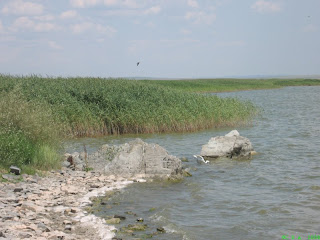 Between Constanţa and Tulcea, on the European road E87 lies the village of Baia, formerly Hamangia. On its nearby territory were found important prehistoric vestiges: to the north-west a neolithic settlement and a group of four mounds and near the lake Goloviţa another neolithic settlement. The village gives its former name to the Hamangia culture. The archaeological findings consist of ceramics (such as the terracotta female figurines) and many other home tools, such as grinders or polished axes.
Between Constanţa and Tulcea, on the European road E87 lies the village of Baia, formerly Hamangia. On its nearby territory were found important prehistoric vestiges: to the north-west a neolithic settlement and a group of four mounds and near the lake Goloviţa another neolithic settlement. The village gives its former name to the Hamangia culture. The archaeological findings consist of ceramics (such as the terracotta female figurines) and many other home tools, such as grinders or polished axes.The neolithic settlement near Baia presents three levels, the oldest being contemporary with the one near lake Goloviţa. The diggings at Ceamurlia de Jos in the years 1952-1955, revealed mostly findings from the 3rd period of the Hamangia culture. Other important archaeological sites for the Hamangia culture are Cernavodă (former Axiopolis) and Durankulak.
Although barely anything can be seen nowadays, here is the Google map .
 On the most eastern promontory, where lake Razelm meets lake Goloviţa, can be found the ancient settlement of Argamum (or Orgame).
On the most eastern promontory, where lake Razelm meets lake Goloviţa, can be found the ancient settlement of Argamum (or Orgame).







 On the shore of Pontus Euxinus - Halmyris bay (today Sinoe lake), in the northern part of present Istria Peninsula, arose 2600 years ago the town of Histria, founded by greek navigators and merchants. Olive oil, wine and other greek products were exchanged for products of the local tribes, such as grains, honey, bee wax, leather or salted fish. The city flourished, even after the roman conquest. But sand deposits began to cut the access to the sea and after the Slavs' and Avars' invasions in the 7th century AD the fortress was abandoned. Excavations began in 1914, under the supervising of the great historian and archaeologist
On the shore of Pontus Euxinus - Halmyris bay (today Sinoe lake), in the northern part of present Istria Peninsula, arose 2600 years ago the town of Histria, founded by greek navigators and merchants. Olive oil, wine and other greek products were exchanged for products of the local tribes, such as grains, honey, bee wax, leather or salted fish. The city flourished, even after the roman conquest. But sand deposits began to cut the access to the sea and after the Slavs' and Avars' invasions in the 7th century AD the fortress was abandoned. Excavations began in 1914, under the supervising of the great historian and archaeologist 









 The ancient Greek seamen and merchants founded, more than 2500 years ago, several colonies on the shores of
The ancient Greek seamen and merchants founded, more than 2500 years ago, several colonies on the shores of 




 I assume it is fair to start the Dobrogea posts with Constanţa, ancient Tomis, the biggest city in the entire region and one of the biggest cities in Romania. But there's too much to tell, so I think I'll post later more info and maybe some pictures.
I assume it is fair to start the Dobrogea posts with Constanţa, ancient Tomis, the biggest city in the entire region and one of the biggest cities in Romania. But there's too much to tell, so I think I'll post later more info and maybe some pictures.